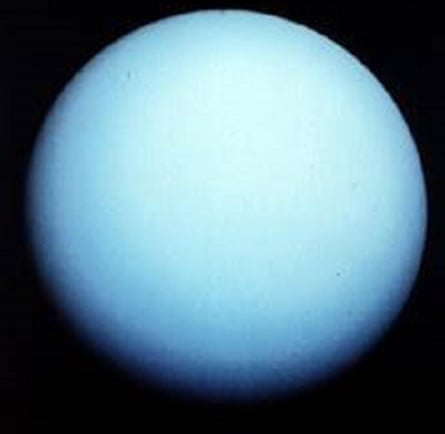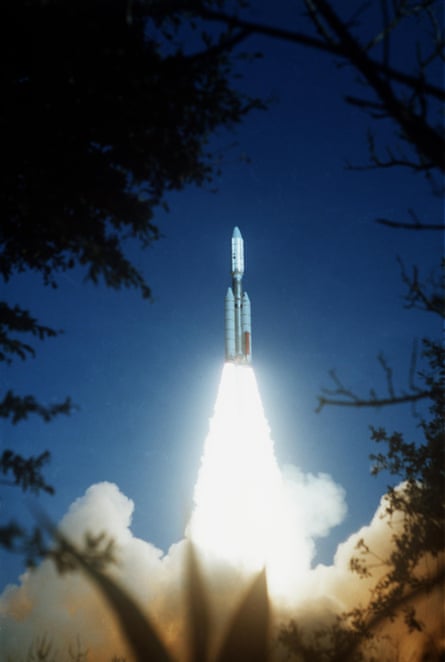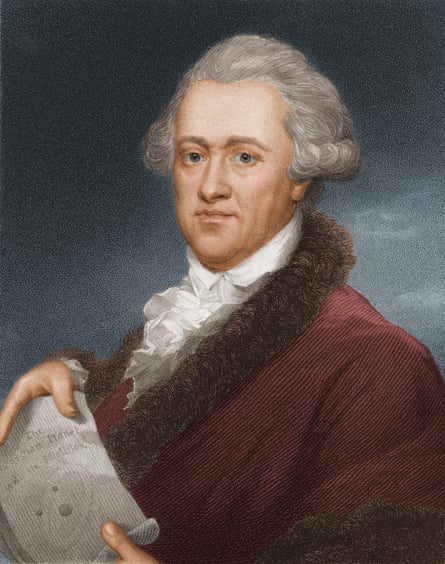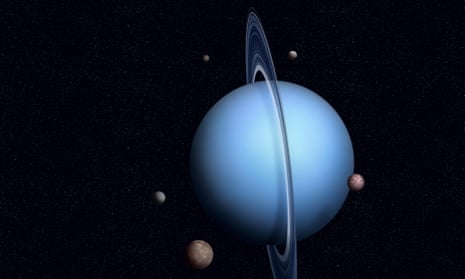On the night of 13 March 1781, William Herschel was peering through his telescope in his back garden in New King Street, Bath, when he noticed an unusual faint object near the star Zeta Tauri. He observed it for several nights and noted that it was moving slowly against background stars. The astronomer first thought he had found a comet but later identified it, correctly, as a distant planet. Subsequently named Uranus, it was the first planet to be discovered since antiquity. The achievement earned Herschel membership of the Royal Society, a knighthood and enduring astronomical fame.
Studies have since shown Uranus to be a very odd world. While the rest of the planets in our solar system spin like tops, Uranus lies on its side. And although it is not the farthest planet from the sun, it is the solar system’s coldest.
Uranus also endures seasons of extraordinary magnitude. Each pole spends decades bathed in non-stop sunlight, before experiencing decades of total darkness. A human being who was born at sunset near the pole disappearing into autumn darkness, would have to wait 42 years to see their first spring sunrise. For good measure, Uranus is the only planet to be named after a Greek rather than a Roman god. (Uranus was the grandfather of Zeus.)
Despite these astronomical oddities and extremes, surprisingly little effort has been made to get up close to Uranus. Only one robot probe has ever visited it – in 1986 – when the US Voyager 2 craft swept past on its grand tour of the solar system. It revealed a massive, featureless, pale blue world with an atmosphere of hydrogen, helium and methane, a rich family of moons and a powerful magnetic field. And that has been that.
Such slight regard is about to change, however. Earlier this year, the US National Academy of Sciences published a report that urged Nasa to launch a Uranus probe as its highest-priority flagship mission for the next decade. The academy publishes a report on US priorities in planetary exploration every 10 years and each decadal survey carries enormous clout – which means Nasa is now under enormous pressure to design and fund such a mission.

For their part, Uranus enthusiasts are delighted. “It is tremendous news,” says planetary scientist Prof Leigh Fletcher, of Leicester University. “There are few places left in the solar system about which we know less than we do about Uranus. The inner planets have been visited many times by probes and so have Jupiter and Saturn. Even tiny, distant Pluto has been surveyed. So a Uranus mission will fill a glaring gap in our knowledge of the processes that shaped our solar system.”
Astronomers divide the sun’s planets into three basic categories. There are Mercury, Venus, Earth and Mars, the rocky inner planets that orbit near the sun. Then, further out there are the gas giants Jupiter and Saturn, huge worlds made mostly of hydrogen and helium. Finally, at the edge of the solar system, there is Uranus and its partner Neptune, respectively the second most distant, and the most distant planet from the sun. These two are called ice giants because they are massive (though not as big as Jupiter and Saturn) and because they are formed from icy material. Crucially, they have high abundances of methane, water and other ice-forming molecules in their atmospheres and interiors. (Beyond these worlds lies Pluto, which was formally declassified as a planet and recategorised as a dwarf planet by the International Astronomical Union in 2006.)
These features were always considered interesting though not sufficiently intriguing to deserve special attention – until astronomers began to study worlds around other stars and found ice giants like Uranus and Neptune were everywhere. “It is really intriguing: when we look at planets around other stars, we find a great many of them are similar to Uranus and Neptune,” adds Fletcher. Or as Jonathan Fortney, a planetary scientist at the University of California Santa Cruz, puts it: “Nature loves to make planets of this size.”
Just why ice giants are widespread in our galaxy is unclear. “However, there is obviously something important about planets like Uranus and Neptune,” says Fletcher. “And crucially we have two great examples of them, the galaxy’s most common planets, right here in our solar system. Yet their composition, their nature, and their origins remain a relative mystery. It is time to put that right.”
Correcting this planetary omission will not be easy, however. Uranus orbits the sun at an average distance of 1.8bn miles (2.8bn km); Neptune at 2.8bn miles (4.5bn km). The former’s relative proximity to Earth therefore makes it the favoured target. Nevertheless, a Uranus mission will still need help reaching its target – in the form of a gravity assist from Jupiter. This sort of manoeuvre has been used on other missions in our solar system and involves a spacecraft sweeping low over a planet that lies on its route. The capsule gains energy from this close encounter and so can carry more instruments and fuel than would otherwise be possible. A rendezvous with Jupiter would therefore result in a Uranus probe that, with more fuel on board, could explore Uranus for longer with a more sophisticated suite of instruments.

But timing is tight. Celestial mechanics dictate that a Uranus mission will have to be launched in 2031 or 2032 to reach Jupiter at the right time to exploit it for a gravity assist. This leaves Nasa with a decade to design the probe, raise the $4bn (£3.3bn) or more that will be needed to build it, complete its construction and then launch it on its 13-year voyage. Given these pressures, and the widespread interest in exploring the ice giants, the project will almost certainly involve the participation of other organisations, such as the European Space Agency.
Most ideas for the mission envisage a main craft that would orbit Uranus, survey the planet while occasionally swinging near some of the its moons and rings for close inspection. A companion probe could also be dropped into the Uranian atmosphere to study its composition.
Apart from finding evidence that might explain why ice giants are common around other stars, the mission would aim to solve many other mysteries about Uranus. Why is the planet so cold, and why is its axis of rotation tilted sideways, almost into the plane of its orbit round the sun, a phenomenon that means its north and south poles lie where most other planets have their equators?
“One theory is that a very large object – a huge asteroid perhaps – hit Uranus some time in the past and knocked it over,” says physicist Prof Patrick Irwin of Oxford University. “Such an event would also explain another strange feature about Uranus: it appears to have almost no internal heat left over from its formation – making it the coldest planet in the solar system.
“Jupiter, Saturn and even Neptune still have some internal heat and emit more energy into space than they gather from the sun. But not Uranus. All its internal heat seems to have disappeared, possibly because that huge impact turned it inside out so that its hot internal contents ended up on the outside and its heat quickly radiated away into space. We need a probe to resolve issues like these.”
It remains to be seen if Nasa can act quickly enough to build and launch a mission as complex as the one needed to study Uranus. Many astronomers are nervous about the tightness of the timetable – although there is one ray of light. In 2011, the National Academy of Sciences published its last decadal survey and urged Nasa that for the next 10 years it should concentrate first on a mission to Mars to start collecting rocks for return to Earth, and second on a probe that would be sent to Europa, the icy moon of Jupiter, to see if it might harbour life. A decade later, the US robot rover Perseverance has already begun the former task, while Nasa’s Europa Clipper is to launch in 2024. “That shows these deadlines can be met and that gives us hope,” says Fletcher.
It remains to be seen how plans for the Uranus mission fare – though there is one intriguing coda to the story of the planet’s selection as a prime destination. As its secondary candidate for a flagship mission over the next 10 years, the National Academy of Sciences has recommended that a spacecraft should be sent to Enceladus. This tiny moon of Saturn behaves in a startling manner. It spews organic-rich plumes of water into space, making it an ideal candidate for sampling in order to search for microbes or other primitive forms of life that might exist on the little moon.
A mission to Enceladus shares many of the complexities that bedevil plans for any mission to a distant gas or ice giant. However, it is also united in a remarkable way to the proposed probe to Uranus. Enceladus was discovered in 1789 – by no less a figure than William Herschel.

Herschel’s discovery remembered
A commemorative stone will be unveiled next month in the garden of 19 New King Street, Bath, to mark the exact spot where William Herschel rested his homemade telescope and first glimpsed Uranus. The event – on 25 August – will form a key part of celebrations, which began this weekend, to mark the 200th anniversary of the death of the German-born astronomer.
Herschel died on 25 August 1822, and the new exhibition at his home – now the Herschel Museum of Astronomy – will include his observation book in which he wrote notes from the night when he first observed Uranus. Also on show will be a catalogue of stars recorded by his sister Caroline, a professional astronomer in her own right, a prolific discoverer of comets, and the first woman to receive a salary as a scientist.
William Herschel was also a gifted musician and could play the oboe, violin, harpsichord and organ and composed numerous concertos and symphonies. His scientific achievements include the first detection of infrared radiation; the observation that the pole caps of Mars vary seasonally; and the later discovery of previously unobserved moons around Saturn.
However, the discovery of Uranus remains his main claim to fame. Intriguingly, Herschel originally wanted to name it after his patron, King George III, which would have made it Georgium Sidus, or George’s Star. However, the moniker was not widely liked outside England and eventually the name Uranus was agreed – although it did not get full international acceptance until the middle of the 19th century.

Comments (…)
Sign in or create your Guardian account to join the discussion